City climbing

I went to my first urban crag last weekend: Quincy Quarries. It’s a filled-in old quarry with mostly top-rope climbs, covered in graffiti, and just a minute or two’s walk from the road. You can even take the T there.
I only did a few climbs — including Outside Corner (5.8), Manic Depressive (5.8), and what I’d guess was a 5.9 or 10a on K-Wall.
- Ropes can get staticky! My fingers were getting shocked consistently as I fed rope while belaying. Weird stuff.
- I got to re-learn rappelling. The more I practice, the less scared I hope to be.
- Aww yeah, the familiar site of blood smears on the rock..
Great PDF of Quincy, with route map, walls, directions
define: voxel
A voxel is the 3D equivalent of a pixel. So, where a pixel is the smallest sample element in a 2D image, the voxel is the smallest sample element in a volume image. The word “voxel” is a combination of “volumetric” or “volume”, and “pixel”.
“Some alternative 3D rendering techniques use voxels to render 3D scenes: whilst it is not a common technique within real-time 3D at the moment, with the increasing power of computers, it will probabally become more important in the future.” ((http://www.machinima.com/article.php?article=69))

What’s the sound of one piano dropping?
 Yesterday was MIT‘s “drop date”, the last day during which you can drop classes. MIT’s drop date tradition is, of course, to drop a piano off of the top of Baker House.
Yesterday was MIT‘s “drop date”, the last day during which you can drop classes. MIT’s drop date tradition is, of course, to drop a piano off of the top of Baker House.
I went to this event, expecting a cacophonous crash full of pops and twangs and vibrating strings, and wood splintering everywhere (“Should I be wearing safety goggles?”). And, to my dismay, the piano had no strings (hence, no crazy resonating sounds), and it really just sort of made a simple wood-breaking sound that seemed too short after what seemed like a very long fall. Still, it *was* loud, and was very silly. So I was happy.
Luis took a video of the occasion. And this guy has some great photos from last year’s event.
More:
- Matt McGann’s blog post about the event (from 2005)
- The Baker House page (from 2005)
- “Bruno – A unit of volume resulting from a piano falling six stories onto Amherst Alley from the roof of Baker House.” ((http://www.mitadmissions.org/topics/life/hacks_traditions/jargon.shtml))
Gastric juices, glass slides, and familiar voices
Trivia from three experiments…
 Pavlov did all his dog experiments initially with the goal of collecting their gastric juices to study digestion. He only changed his research to conditioning after he realized the dogs tended to salivate before they even had the food. There is a picture of Pavlov’s taxidermied dog (left) on the Wikipedia page, and here is a little browser someone at Cold Spring Harbor is inspired enough to maintain, on all of Pavlov’s dogs.
Pavlov did all his dog experiments initially with the goal of collecting their gastric juices to study digestion. He only changed his research to conditioning after he realized the dogs tended to salivate before they even had the food. There is a picture of Pavlov’s taxidermied dog (left) on the Wikipedia page, and here is a little browser someone at Cold Spring Harbor is inspired enough to maintain, on all of Pavlov’s dogs.
Hubel and Wiesel accidentally stumbled onto the start of their Nobel-prize winning discovery on the visual cortex in cats, by getting a slide stuck at an angle while loading it to view in the projector. The edge of the glass slide created a sharply contrasting line at an angle that triggered activity in the cat brains.
After unjamming the slide, they slowly pushed it into its slot. Suddenly the electrode monitor started firing like “a machine gun.â€
(from http://www.nytimes.com/books/first/h/horgan-mind.html?_r=1&oref=slogin)
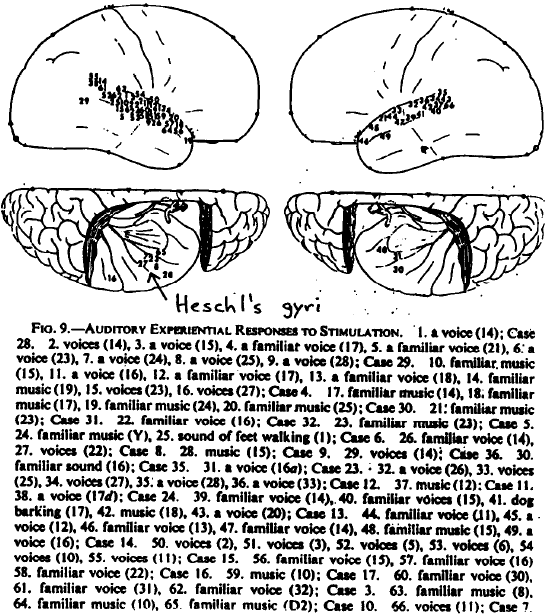 Wilder Penfield electrically stimulated epileptic patients’ brains in an attempt to map the human cortex. He found that stimulation in the superior temporal lobe could give the patient a sensation of familiar voices, music, and memories. I find the accompanying picture ((from Penfield and Perot, 1963)) very amusing. (“sound of feet walking”??)
Wilder Penfield electrically stimulated epileptic patients’ brains in an attempt to map the human cortex. He found that stimulation in the superior temporal lobe could give the patient a sensation of familiar voices, music, and memories. I find the accompanying picture ((from Penfield and Perot, 1963)) very amusing. (“sound of feet walking”??)
Spectrograms to hide images in music
Spectrograms are pictures of sound over time. People use them to visualize waveforms, often to try to highlight musical relationships or sounds in speech.
Here’s what someone saying “She sells sea shells” looks like (spectrogram on bottom):

You can go the other way, too, by drawing a picture in a spectrogram and playing the sound it represents. Several musicians have used this to hide pictures in their albums. In many cases, you’ll hear some weird noise at the end of a track… and when the waveform is put through a spectrum analyzer, you get the picture back.
There are some fairly ridiculous examples of this…
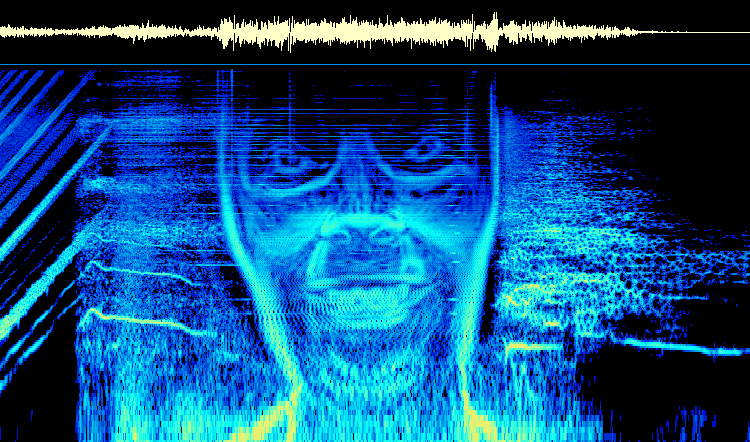 Aphex Twin: Windowlicker |
 NIN: viral marketing |
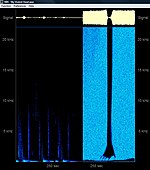 NIN: My Violent Heart |
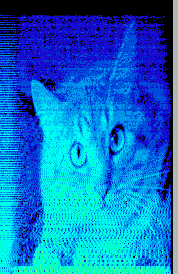 Venetian Snares: Songs About My Cats |
A good description of finding these hidden pictures can be found here: http://www.bastwood.com/aphex.php
…and, of course, there is a Wikipedia section devoted to it.
Last.fm widget
Yay!! Ian finished up the first version of the last.fm widget we started working on when he visited in February. This widget allows you to enter in your friends’ (or un-friends’) last.fm usernames, and track what everyone is listening to… sortable by time, artist, and user. As far as I know, there isn’t another last.fm widget out that lets you track multiple users at once.
Here’s what mine looks like right now:
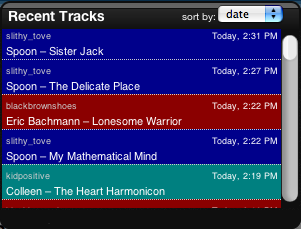
If you’re using Mac OS X 10.4+, go ahead and download the widget. Feedback is much appreciated!
Note: The widget only reloads songs if at least 15 minutes have passed since it last loaded everyone’s songs. To force a reload, just hold down the OPTION key and click in the bottom-left where it usually says “Loading…”.
(My username is dorq, in case you want to see what I’ve been listening to.)
Lightning and thunder (and tweeks, sferics, and whistlers)
 The sound that comes from lightning sounds the way it does – a crack followed by a rumble – because the high frequency sounds from the explosion travel more quickly through the atmosphere than the lower frequency sounds. This is called “dispersion” ((http://www.physics.uoguelph.ca/summer/scor/articles/scor163.htm — best link if you’re just going to read one of these)). It’s the same phenomenon that you see in optics when light gets split through a prism.
The sound that comes from lightning sounds the way it does – a crack followed by a rumble – because the high frequency sounds from the explosion travel more quickly through the atmosphere than the lower frequency sounds. This is called “dispersion” ((http://www.physics.uoguelph.ca/summer/scor/articles/scor163.htm — best link if you’re just going to read one of these)). It’s the same phenomenon that you see in optics when light gets split through a prism.
The farther you are from the lightning, the more low frequency sound you will hear in the thunder ((http://www.madsci.org/posts/archives/nov99/943317470.Ph.r.html)). This is due to both dispersion, which attenuates the high frequencies more ((http://www.physics.uoguelph.ca/summer/scor/articles/scor163.htm)), and diffraction, which helps low frequency sounds “bend around” obstacles better than high frequency sounds ((http://hyperphysics.phy-astr.gsu.edu/hbase/sound/diffrac.html)), so they can travel farther.
Radio waves are affected by dispersion as well. While reading about lightning and thunder, I stumbled across this amazing thing: very low frequency (VLF) radio receivers for the Earth’s natural radio emissions. The sound samples on this page are really cool.
This is crazy stuff. You can listen to a live VLF audio stream through the NASA online VLF receiver.
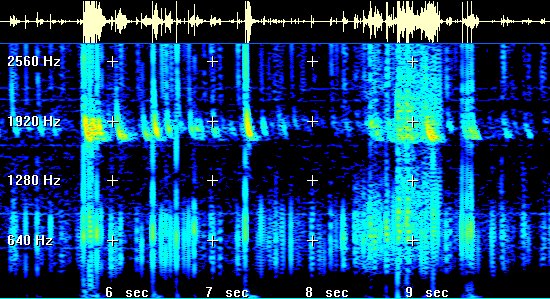
Word of the day: prosody
(from my handy dashboard dictionary, which for some reason does not have galavanting…)
prosody:
- the patterns of rhythm and sound used in poetry
- the patterns of stress and intonation in a language
The mysterious Coriolis force
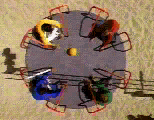 I remember the term “Coriolis force” from some ancient high school physics class, I think. But when Joe P showed us this phenomenon again in class last week, I could swear I’ve never ever thought about it before. It’s a little baffling to me at the moment (and therefore worth thinking about!).
I remember the term “Coriolis force” from some ancient high school physics class, I think. But when Joe P showed us this phenomenon again in class last week, I could swear I’ve never ever thought about it before. It’s a little baffling to me at the moment (and therefore worth thinking about!).
Compare the simple video on the Coriolis force Wikipedia page with the merry-go-round video on this page. Now figure out how cyclone winds rotate along the Earth’s surface… and you’re all set!
What is a nor’easter
 Apparently I missed another “nor’easter” last weekend while I was off in sunny, life-warming California. I thought a nor’easter was just a storm in the northeastern US. The trusty Wikipedia tells me not only what a nor’easter is, but also has a whole page devoted to the storm Boston just had.
Apparently I missed another “nor’easter” last weekend while I was off in sunny, life-warming California. I thought a nor’easter was just a storm in the northeastern US. The trusty Wikipedia tells me not only what a nor’easter is, but also has a whole page devoted to the storm Boston just had.
A nor’easter … is a macro-scale storm whose winds come from the northeast, especially in the coastal areas of the Northeastern United States and Atlantic Canada. More specifically, it describes a low pressure area whose center of rotation is just off the coast and whose leading winds in the left forward quadrant rotate onto land from the northeast. The precipitation pattern is similar to other extratropical storms. They also can cause coastal flooding, coastal erosion and gale force winds.
I missed the last listed nor’easter (November 2006) while I was in St. Louis. And last month, while I was in Seattle, I missed another storm. Is coincidence??
